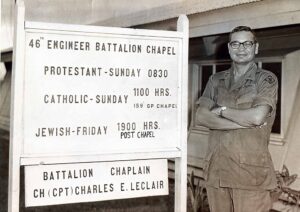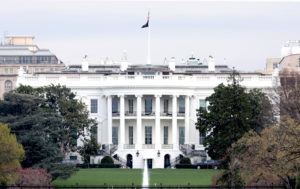
GARY, Ind. (BP) — In the Griffin house, even the dog is polite. At a command from dad Roman Griffin, the golden retriever/chow mix skitters to her cage without a whimper. When a visitor steps in the front door, six children ranging from 5 to 17 — including twins and a nephew — sit beneath family photos in a red living room to offer their attention.
Naomi, 8, wears Hello Kitty slippers and a toothy grin. She says she’d like to be a preacher, teacher, fireman, policeman, scientist, and “play all the instruments.” Her brother, 11-year-old Jailon, wants to “write fiction stories, mostly for kids and babies,” and has learned at school that “anything is possible when you have God in your life.”
Last year Naomi, Jailon, and an older brother, Roman Jr., left two public schools to attend Ambassador Christian Academy in Gary, Ind. They did so only because state-provided vouchers paid for the $4,300 in tuition and fees. Their parents, Roman and Sheila, support the household of eight with a combined $35,000 or so they net each year from jobs as a barber and receptionist.
Jailon and Naomi will attend Ambassador again this fall with vouchers. Roman Jr. will use one to attend a Catholic high school. Roman and Sheila Griffin aren’t sure if they’ll have the money to send their 5-year-old twin girls, ineligible for state vouchers, to Ambassador’s kindergarten class this year. “If we could afford it they would have all been in a Christian school from the start,” Sheila said.
As Indiana’s path-breaking voucher program charts its second year, the Griffin children are among thousands of Hoosier students using state dollars to attend private schools. About 300 private, largely Christian schools in the state are accepting voucher students — and gaining a financial boost as they arrive. The boost once was rare, but the school choice movement is surging, thanks to Republican statehouse efforts with occasional Democratic support. The impact in Indiana could predict how Christian schools will benefit from new school choice programs in states such as Louisiana.
Inside Ambassador Academy on a recent summer day, day campers drew with crayons in art class and jumped to a pop song in gym class. The school, sponsored by a local nondenominational church, crouches in an area of Gary where most streets host boarded windows and overgrown lawns. Ambassador served about 300 students from pre-K to eighth grade during the last school year. A third of them used vouchers.
Previously, enrollment was declining, school principal Vercena Stewart said — but vouchers opened the door for Ambassador to attract families like the Griffins, who couldn’t otherwise afford private school. The increased attendance has given Ambassador a financial leg up: As it aims to fill 396 seats this year — half of them with voucher students — the school has hired a new third-grade teacher and spent more than $100,000 on textbooks.
At Trinity Academy, another Christian school a few blocks away, linoleum peeled off the floor in a blue boys’ restroom one afternoon in late June. In George M. Howard Jr.’s office, formerly a storage room, wires hung from an empty fluorescent light fixture, and the bathroom sink was clogged. But Howard, the school’s executive administrator, is all optimism: “We’re planning on buying 28 computers this year.” Voucher funds will make that possible.
Trinity will remodel the restrooms and make other improvements as part of a plan to jump its enrollment from 50 to 114 students from preschool to sixth grade. Gary public schools laid off a quarter of their teachers this summer to stem a budget crisis, but Trinity plans to hire two more.
Vouchers even will help Gary’s first private middle school, Mosaic, open its doors on Aug. 22. The school is nonreligious and will follow what executive director Andrea Coffer called an “expeditionary learning” style, with activities such as studying microorganisms from Lake Michigan. Mosaic was already considering opening before last year, but Coffer said, “Once the voucher program came about, we thought, this is a no-brainer.”
The picture in Gary reflects what is occurring throughout Indiana. As years of recession squeezed family budgets, private schools in the state (as elsewhere in the nation) watched enrollment trickle away. But last year some accredited Christian schools picked up voucher students by the dozens.
Liberty Christian School in Anderson added almost 120 voucher students last year, increasing regular enrollment by one-fifth. In Fort Wayne, Blackhawk Christian School accepted 42 voucher students; this year it expects as many as 85. Of the 259 private schools approved to accept vouchers last year, 254 were Christian, one was Muslim, and four were secular. All the schools submitted to standardized testing, in accordance with state rules.
Enrollment at Indiana’s Catholic schools had slipped over the course of a decade by several thousand students until last year, when — according to a Wall Street Journal analysis — Catholic school enrollment across the state jumped 2 percent. Another bump is likely this fall, as more parents are aware of voucher availability. As early as June, 5,000 students had already applied for Indiana vouchers, surpassing last year’s total program participation.
Indiana’s GOP-dominated legislature last year made the “Choice Scholarship” law the largest first-year voucher program in the nation with nearly 4,000 vouchers awarded. The vouchers aren’t for just anybody, though: Children from high-income families may not receive them, and those who already attend private schools are ineligible. Kindergartners are also ineligible; voucher participants must have attended a public school for at least one year.
Most conservative legislators in Indiana voted for the voucher program, although a few were concerned it could pave the way for the state to regulate private schools, said Rep. Timothy Wesco, whose district includes portions of Elkhart. Wesco supports vouchers but shares long-term concerns: “I think eventually the schools are going to depend on that voucher money.”
The average Indiana voucher was worth $4,150 last year. Since Indiana normally spends around $11,000 to educate a public-school student, the program saved the state millions of dollars. State officials returned $4.2 million in savings to public schools. Even so, critics of the program argue that it steals money from public-school coffers, resulting in layoffs.
“The money doesn’t belong to public schools,” snaps Indiana’s Superintendent of Public Instruction, Tony Bennett, when he hears those complaints. The state’s responsibility is to “fund the education of children, wherever they go,” in an effort to supply the best education possible. Bennett, a Catholic school graduate, said Indiana’s voucher law wasn’t intended to reverse Catholic school enrollment decline. But if those vouchers have enabled students to “leave public schools that didn’t meet their needs, and go to private schools or Catholic schools that meet [them], I’m pretty agnostic about that.”
If Bennett is agnostic, the Indiana State Teachers Association is devout: It has sued the state. In a case before the Indiana Supreme Court, the teachers union claims the vouchers violate the state’s constitution, which, as in many other states, prohibits tax dollars from supporting religion. (Ten years ago the U.S. Supreme Court declared vouchers constitutionally valid.)
Local constitutional challenge is routine for school choice programs. In Oklahoma in March, a Tulsa County district judge struck down a voucher program created for special-needs students, saying it amounted to state support of religious institutions. Oklahoma’s Supreme Court is hearing that case.
This fall, with more than 5,000 vouchers worth up to $8,800 apiece available for low- and middle-income families hoping to escape failing schools, Louisiana is on track to outpace Indiana’s first-year enrollment record. (The state’s preeminent teachers union has taken the Louisiana board of education to court.)
About 120 private and Christian schools in the Bayou State scurried this summer to make room for new students and get the word out to parents. Old Bethel Christian Academy in Clarks had 59 seats available for voucher students and spent about $400 advertising them in local newspapers. According to Lynette Weeks, a school secretary, Old Bethel had only received about 20 voucher applications in time for a June 29 deadline, perhaps indicating parental apathy or misinformation. Some other Christian schools in Louisiana had made 100 or more seats available, hoping to boost enrollment.
Ten states offer vouchers of various kinds, and so does the District of Columbia. Mitt Romney, the presumptive GOP presidential nominee, wants more: Romney’s education reform plan, released in May, proposes expanding charter schools and making the D.C. program a “model for the nation.” Romney promised, if elected, to “expand parental choice in an unprecedented way.” State-financed vouchers aren’t the only door into private schools: Louisiana, Indiana and nine other states have enacted “scholarship tax credit” programs, where individuals or corporations get a tax break if they fund student scholarships. In late June, New Hampshire established such a scholarship program when the Republican-led legislature overrode a veto from Gov. John Lynch, a Democrat.
Overall, 19 states passed various school choice laws during the 2011/2012 state legislative sessions, according to the American Federation for Children, an advocacy group. By expanding programs or creating new ones, lawmakers across the United States have tripled the available funding for vouchers and tax credit scholarships during the past five school years.
Adam Emerson, a school choice expert at the Thomas B. Fordham Institute, says the 2010 elections gave Republicans the edge they needed in many statehouses to vote up school choice policies. At the same time, some Democrats, for whom school choice has traditionally been a taboo subject, began throwing in their support, risking the ire of teachers unions. They may have realized that vouchers and scholarships are especially beneficial to disadvantaged kids disproportionately represented among a major Democratic constituency: minorities.
Emerson points to many African-American lawmakers not only backing educational choice bills but sponsoring them. In North Carolina, for example, Rep. Marcus Brandon, a black Democrat, joined a white Democrat and two white Republicans this year in sponsoring a bill that would have given tax credits to businesses that fund scholarships. In Florida, nearly half of Democrats, and most members of the black and Hispanic caucuses, have supported a similar scholarship program that 38,000 students used last year.
That unusual bipartisan cooperation doesn’t hold everywhere. Not a single Democrat voted for Indiana’s voucher law. Yet it’s clear many minority students in the state are benefiting: At Ambassador and Trinity, about 95 percent of the students are African-American.
Stewart, the principal at Ambassador, sometimes gets pushback to her acceptance of vouchers: “Some of my colleagues in public schools feel that we have stolen children from their coffers.” But opponents of school choice initiatives are having trouble gaining traction, apart from occasional judicial rulings citing constitutional roadblocks. No school choice programs have fallen into disfavor in states where they’ve taken root. Instead, enrollment has gone up.
That’s good news for families like the Griffins. Roman and Sheila say Ambassador had a positive spiritual effect on their kids. “We are not anti-public school, necessarily,” Sheila said, “but we are grateful to have our first choice, our first pick, which is [a] Christian school.”
–30–
Daniel James Devine writes for World News Service, where this story appeared. Get Baptist Press headlines and breaking news on Twitter (@BaptistPress), Facebook (Facebook.com/BaptistPress ) and in your email ( baptistpress.com/SubscribeBP.asp).













